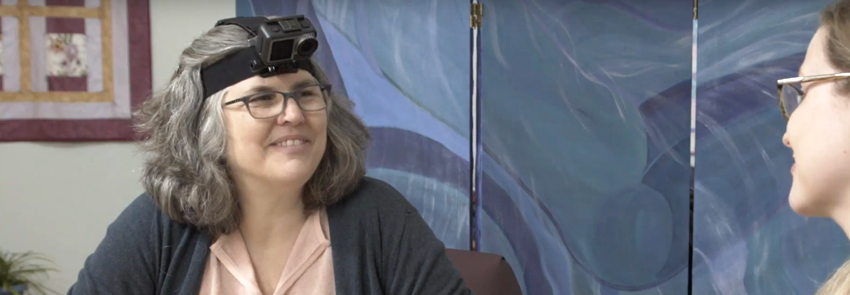
NTR 495: Teaching Clinical Lactation through Virtual Reality
Clinical Concepts in Infant Feeding (NTR 495/594) was a newly developed in-person and online course at NC State, existing as a part of a series to prepare students for the lactation consultant board certification. The student population consisted of students seeking board certification and those seeking general clinical experience.
The proposal “Teaching Clinical Lactation through Virtual Reality” was submitted as an Exploratory Grant by principal investigators (PI) Nicola Singletary, Ellen Chetwynd and April Fogleman of NC State’s Nutrition department. The project goal was to provide a virtual simulation of what a real-life lactation consultation would look like, helping students to become more comfortable with the clinical and soft skills required to be successful consultants. The PI’s initially proposed that this learning objective could be achieved through a virtual reality environment.
In the original course format, students attended a live class where volunteer mothers were brought in to share their experiences with infant feeding and consent for students to practice their clinical lactation techniques. The live discussions between mothers and students were recorded for use online. Some students found this helpful, but others reported that they still felt awkward and overwhelmed with real clients. The PIs were seeking a way to better prepare students for real-life experience.
Instructional Challenges
- The experience did not adequately represent a consultation in feel or flow because the instructors had to conduct a consultation and teach simultaneously.
- Students gathered around to observe with the instructor interrupting the consultation to point out important parts to students.
- Instructors felt that soft skills and clinical skills were not covered to the extent they wanted.
- Only one or two students could get the POV of consultant, and it could be hard to hear what she was saying because of the physical constraints of the environment.
- Students had a feeling of watching someone else, as opposed to having a first-person feel that would increase student confidence.
- The broad scope made it harder to find a focus. This led to many discussions about what knowledge and skills the PIs wanted students to get out of the course and in what areas the students were struggling.
Developmental Challenges
- It was not possible to strictly script the interactions and conversations the PIs wanted to include.
- There were issues of control with babies during consultations.
- Students could not get everything in one consultation and had to piece together four consults.
Highlights/Solutions
- The team came to a consensus that eliminating fear and awkwardness of the clinical lactation environment with a mother and baby was the primary objective.
- The second objective was to allow students to imagine what the lactation consultant’s cognitive process was during the consultation, to provide concrete examples of flexibility and critical thinking on the fly.
- The team used an “outside in” approach to filming, using multiple cameras from different angles.
- The team determined that what is typically called an “immersive approach” (generally 360 video and/or VR) was not the right fit. The PIs wanted students to get a general sense of lactation consultation requirements and what challenges might be faced in a real-life clinical setting, which called for a combination of first-person and third-person perspectives.
- The team identified instructional themes to include.
- The team identified soft skills and clinical skills to capture.
- The team shot using multiple angles.
- The team created two versions of the videos to eliminate the disconnect and confusion of instructors trying to conduct a clinical consultation with a mother and baby while simultaneously teaching students. In the first version, students observed the consultation without instructional sidebars. The second version allowed students to hear the instructor’s voiceover to cover clinical skills, explain their critical thinking and add commentary on what they were doing and why. Separating the instructional purpose of the video resulted in the first version conveying the feel and flow of a clinical lactation consultation, and the second version fully covering clinical skills.
- The team thought finding moms would be tough, but this was not the case. Due to the sensitive nature of the instructional content, we obtained an additional waiver from university for moms.
Evaluation Findings
- Students perceived the immersive videos as engaging as well as supporting critical thinking, making of knowledge connections, and understanding the importance of clinical assessments. Further, they reported experiencing minimal challenges interacting with the videos and often viewed them more than once.
- Students also agreed that PlayPosit and SOAP activities helped them better understand/apply content, were beneficial for their learning, and required them to think critically/carefully.
- Overall, students showed a significant increase in clinical lactation self-efficacy and perceived skill level across the semester. No changes in interest and breastfeeding attitude were observed.
For more information about DELTA services, please contact LearnTech.